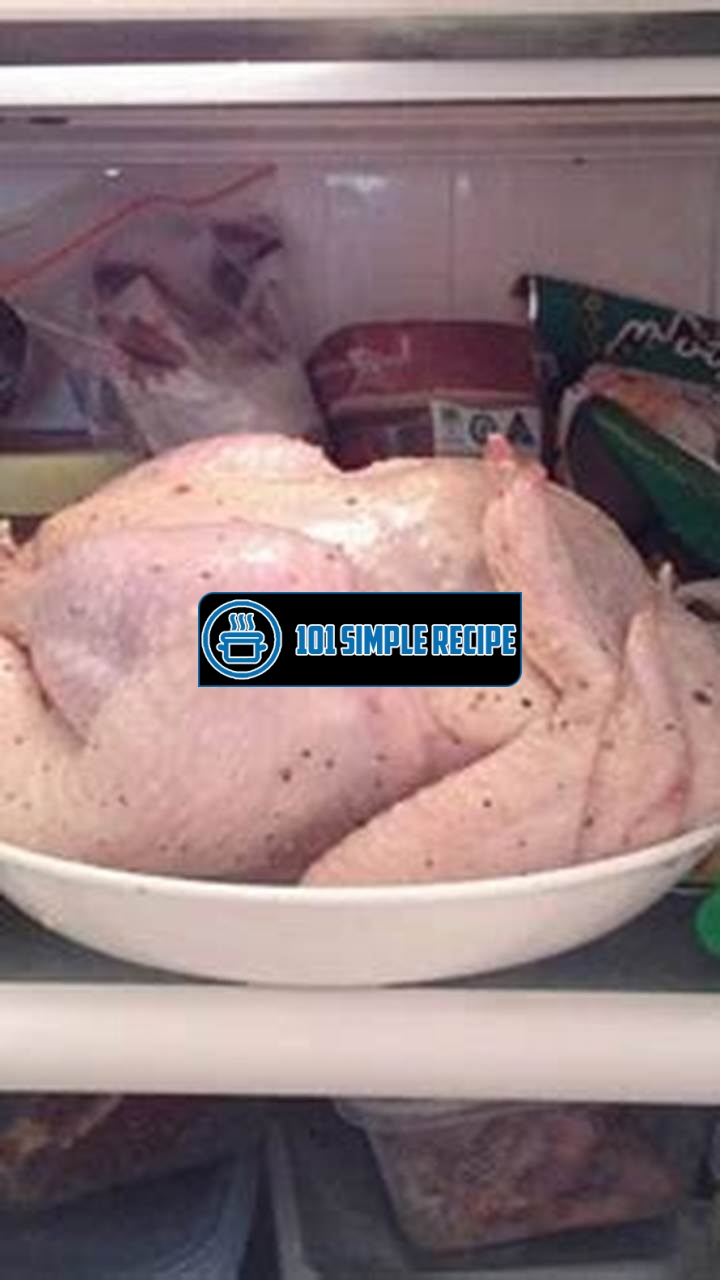Are you wondering how long you can safely keep raw chicken breast in your fridge? Well, you’re in the right place! In this article, we will provide you with all the information you need to ensure you are storing your chicken properly and consuming it while it’s still safe to eat. But before we dive into the specifics, let’s take a moment to highlight the importance of handling raw chicken with care. Raw poultry can be a source of harmful bacteria, so it’s crucial to understand the timelines for its safe storage. We will also provide some useful tips on how to store chicken breast to maximize its freshness and prevent any potential health risks. So, let’s get started and learn how long raw chicken breast stays good in the refrigerator! ️

The Importance of Proper Food Storage
Proper food storage is crucial for maintaining food safety and preventing spoilage. When it comes to raw chicken breast, understanding how long it remains good in the fridge is essential for avoiding potential health risks. By following recommended guidelines for food storage, you can ensure that your chicken stays fresh and safe to eat.
Understanding Food Shelf Life
Food shelf life refers to the length of time that a particular food item can be stored before it starts to deteriorate and become unsafe for consumption. For raw chicken breast, the shelf life can vary depending on several factors, such as the temperature of your refrigerator and the packaging of the chicken.
The general guideline for storing raw chicken breast in the fridge is to consume it within 1 to 2 days of purchase. This ensures that the chicken remains at its peak freshness and minimizes the risk of bacterial growth. However, it’s important to note that this timeframe might change if the chicken is not stored properly.
Tip: Always check the expiration date on the packaging before purchasing raw chicken breast. This will give you a better idea of how long it will remain good in your fridge.
Health Risks of Consuming Spoiled Food
Consuming spoiled food, including raw chicken breast, can pose serious health risks. When food is left in the fridge for too long and becomes spoiled, it can harbor harmful bacteria such as Salmonella or Campylobacter. These bacteria can cause foodborne illnesses, resulting in symptoms like nausea, abdominal pain, diarrhea, and vomiting.
If you accidentally consume spoiled chicken, it’s crucial to seek medical attention if you experience severe symptoms or if you belong to a high-risk group, such as infants, pregnant women, older adults, or individuals with weakened immune systems.
Tips for Proper Food Storage
To ensure that your raw chicken breast stays fresh and safe for consumption, follow these tips for proper food storage:
- Keep it refrigerated: As soon as you bring raw chicken breast home from the store, promptly store it in the refrigerator. Ensure that your fridge maintains a temperature below 40°F (4°C) to slow down bacterial growth.
- Store in leak-proof packaging: Place the raw chicken breast in a leak-proof, airtight container or wrap it tightly in plastic wrap or foil to prevent cross-contamination and to maintain its quality.
- Separate from other foods: Store raw chicken breast separately from other foods, especially ready-to-eat items, to prevent any potential contamination.
- Don’t store for too long: Consume raw chicken breast within 1 to 2 days of purchase to ensure optimal freshness and reduce the risk of bacterial growth.
- Use the “sniff test”: Before cooking, give the raw chicken breast a sniff. If it has an unusual or foul odor, it’s best to discard it to avoid any potential health risks.
Note: These tips are applicable for raw chicken breast. It’s important to follow specific guidelines for other types of raw meat or poultry to ensure food safety.
By understanding the importance of proper food storage and following these guidelines for raw chicken breast, you can maintain food safety and minimize the risk of consuming spoiled food. Remember, when it comes to your health and the health of your loved ones, it’s better to be safe than sorry.
Factors Affecting the Shelf Life of Raw Chicken Breast
Discover the various factors that can impact how long raw chicken breast is good in the fridge.
Temperature and Humidity
When it comes to preserving the quality and safety of raw chicken breast in the fridge, temperature and humidity are crucial factors to consider. ️
Raw chicken breast should always be stored at a temperature below 40°F (4°C) to inhibit the growth of harmful bacteria. The fridge should be set at a temperature range of 32°F to 40°F (0°C to 4°C) to ensure optimal storage conditions. Storing raw chicken breast at higher temperatures can accelerate bacterial growth and shorten its shelf life.
In addition to temperature, the humidity level in the fridge also plays a role in determining how long raw chicken breast remains good. High humidity can promote the growth of mold, while low humidity can cause the chicken breast to dry out quickly, leading to quality deterioration. ️
To maintain the ideal humidity level, keep raw chicken breast in a sealed container or wrap it tightly with plastic wrap to prevent moisture loss. This helps to retain its moisture content and extend its shelf life.
Packaging and Sealing Methods
The packaging and sealing methods used for raw chicken breast greatly influence its shelf life.
If the chicken breast is purchased from a grocery store, it is typically packaged in airtight containers or vacuum-sealed bags. These containers or bags are specifically designed to preserve freshness and prevent contamination. When storing the chicken breast, it is important to leave it in its original packaging until ready to use.
If the chicken breast is not purchased in airtight packaging, it should be transferred to airtight containers or resealable bags. This helps to minimize exposure to air and limits the growth of bacteria and other microorganisms. It is crucial to ensure proper sealing to maintain the quality and safety of the chicken breast.
When wrapping raw chicken breast with plastic wrap, make sure it is tightly sealed to prevent air from entering. You can also use freezer-safe zip-top bags, pressing out as much air as possible before sealing them. These methods help to create a barrier against air, moisture, and contaminants, thereby prolonging the shelf life of the chicken breast.
Freshness of the Chicken Breast
The freshness of the chicken breast at the time of purchase is a significant factor in determining how long it will remain good in the fridge.
When buying raw chicken breast, it is important to check the expiration or “sell by” date on the packaging. The closer the chicken breast is to the expiration date, the shorter its remaining shelf life will be. Choose chicken breast that has the furthest expiration date to ensure it will stay fresh in your fridge for a longer period.
In addition to the expiration date, pay attention to the appearance and smell of the chicken breast. Fresh chicken breast should have a pinkish color and a mild, fresh odor. If it appears grayish or has a strong, unpleasant smell, it may indicate spoilage and should not be consumed.
It is essential to handle and store raw chicken breast properly to maintain its freshness. As soon as you bring the chicken breast home, refrigerate it promptly and store it in the coldest part of the fridge, away from other foods to prevent cross-contamination.
In summary, maintaining the proper temperature and humidity, utilizing appropriate packaging and sealing methods, and ensuring the freshness of raw chicken breast are vital for extending its shelf life in the fridge. By following these guidelines, you can safely enjoy your chicken breast for an optimal duration.
Properly Storing Raw Chicken Breast in the Fridge
When it comes to raw chicken breast, proper storage is crucial to maintaining its freshness and preventing foodborne illnesses. By following the correct techniques, you can ensure that your chicken stays safe to consume and delicious for a longer period in the fridge. Here are some tips to help you store raw chicken breast effectively:
Choosing the Right Storage Containers
Before placing raw chicken breast in the fridge, it is essential to select the appropriate storage containers. Opt for containers that are airtight and leak-proof to prevent any cross-contamination with other foods and to keep the chicken moist. Using glass or BPA-free plastic containers is advisable to minimize any potential health risks. Make sure the containers are thoroughly cleaned before use to maintain good hygiene.
Placement of Raw Chicken Breast in the Fridge
Where you store your raw chicken breast in the fridge can make a significant difference in its longevity. It is crucial to keep the chicken away from other foods, particularly those that will be consumed raw, to prevent any cross-contamination. Raw chicken should be stored in the coldest part of the fridge, usually the bottom shelf or meat drawer. This helps maintain the chicken’s temperature and prevents it from coming into contact with foods that are prone to spoilage.
Additionally, it is advisable to keep the chicken in its original packaging if it is well-sealed. If the original packaging is damaged or not suitable for storage, you can transfer the chicken to airtight containers or wrap it tightly in plastic wrap or aluminum foil. This further ensures that the chicken does not come into contact with any other items in the fridge.
Tips for Organizing Your Fridge
Proper organization of your fridge can contribute to the freshness and longevity of your raw chicken breast. Here are some helpful tips:
- Separate and Label: Make sure to keep raw chicken breast separate from other foods by placing it in a designated area. Clearly label the container to avoid any confusion.
- Use Fridge Storage Bags: Consider using specialized fridge storage bags designed to control temperature and minimize the risk of cross-contamination. These bags are convenient and can be easily disposed of.
- Arrange by Temperature: When organizing your fridge, keep in mind that different areas have different temperature zones. Place raw chicken breast in the coldest area, dairy products in the middle, and vegetables in the crisper drawer.
- Regularly Clean and Check: It is essential to regularly clean your fridge and check for any expired or spoiled items. This helps maintain a safe and hygienic environment for storing your raw chicken breast.
Remember, proper storage of raw chicken breast in the fridge can help prevent foodborne illnesses and maximize its freshness. By following these techniques, you can ensure that your chicken stays safe for consumption and retains its taste and texture.
By choosing the right storage containers, placing the chicken correctly in the fridge, and organizing your fridge effectively, you can extend the shelf life of your raw chicken breast. Additionally, always remember to check the expiration date before consuming any chicken to ensure its safety. Stay mindful of food safety guidelines to protect yourself and your loved ones.
Baking Soda Weight Loss Recipe
Signs of Spoiled Raw Chicken Breast
When it comes to raw chicken breast, it is crucial to ensure that it is fresh and safe to consume. Recognizing the signs of spoiled chicken breast is essential in order to avoid any potential health hazards. In this section, we will discuss three key indicators that determine if raw chicken breast has gone bad and should not be consumed. These indicators include visual changes in appearance, unpleasant odor, and texture and consistency changes. By being vigilant and observant, you can protect yourself and your loved ones from consuming spoiled chicken breast.
Visual Changes in Appearance
One of the first signs that raw chicken breast has gone bad is the visual changes in its appearance. Fresh chicken breast should have a pink color, with a slightly translucent and moist look. If you notice any discoloration, such as gray or green patches, it is a clear indication of spoilage. Additionally, if the chicken breast appears slimy or sticky to the touch, it is a red flag. These visual changes in appearance indicate the presence of bacteria or mold, making the chicken unfit for consumption.
Unpleasant Odor
Another clear sign that raw chicken breast has spoiled is the development of an unpleasant odor. Fresh chicken breast should have a neutral or mild smell. However, if you detect a strong, foul odor similar to ammonia or sulfur, it is a strong indication of spoilage. This odor is produced by bacteria that have begun to break down the proteins in the chicken. It is important to note that a slight smell may be present when you first open the package due to the packaging process, but it should dissipate quickly. If the odor lingers or intensifies, it is best to discard the chicken immediately.
Texture and Consistency Changes
The texture and consistency of raw chicken breast can provide important clues regarding its freshness. Fresh chicken breast should feel firm and have a slightly springy texture. If you notice any sliminess or a sticky feel, it indicates spoilage. Another texture change to watch out for is a grainy or mealy texture, which suggests that the chicken has begun to break down. Additionally, if you observe any significant changes in the appearance of the muscle fibers, such as a stringy or mushy texture, it is a sign of spoilage. When in doubt, it is better to err on the side of caution and discard the chicken.
In conclusion, being able to recognize the signs of spoiled raw chicken breast is crucial in order to avoid potential foodborne illnesses. When inspecting raw chicken breast, pay attention to visual changes in appearance, such as discoloration and sliminess, as well as the development of an unpleasant odor. Furthermore, monitor any textures or consistencies that seem abnormal or different from fresh chicken breast. By following these guidelines, you can ensure that the chicken you consume is safe and free from spoilage. Stay vigilant and prioritize food safety!
Guidelines for Safe Consumption of Raw Chicken Breast
Understand the recommended safety guidelines for consuming raw chicken breast stored in the fridge.
Recommended Storage Timeframe
When it comes to raw chicken breast, it is essential to follow specific guidelines to ensure its safety for consumption. One crucial aspect to consider is the recommended storage timeframe. Raw chicken breast should ideally be stored in the refrigerator at a temperature below 40°F (4°C). It is important to note that refrigerating chicken at temperatures above this threshold increases the risk of bacterial growth and foodborne illnesses.
To ensure the freshness and quality of raw chicken breast, it is best to consume it within two days of purchase. However, if the chicken breast has been properly wrapped and sealed, it can be stored for up to four days. Beyond this timeframe, the chances of bacterial growth significantly increase, putting you at risk of foodborne illnesses such as salmonella or campylobacter.
Properly Cooking Raw Chicken Breast
When it comes to cooking raw chicken breast, it is crucial to ensure that it is cooked thoroughly to eliminate any potential bacteria. This not only enhances its taste and texture but also ensures its safety for consumption.
To cook raw chicken breast properly, follow these steps:
- Before cooking, make sure to wash your hands thoroughly with soap and warm water. This helps minimize the transfer of bacteria.
- Use separate utensils and cutting boards for raw chicken to prevent cross-contamination.
- Preheat the oven or stove to the appropriate temperature as recommended in the recipe.
- Place the raw chicken breast on a clean surface and season it according to your preference.
- Cook the chicken breast until the internal temperature reaches 165°F (74°C) to ensure proper doneness and eliminate any harmful bacteria.
It is important to note that cutting into the chicken breast and checking the color alone is not a reliable method to determine its doneness. The best way to ensure safety is by using a meat thermometer to measure the internal temperature.
Alternative Cooking Methods
While traditional cooking methods such as baking, grilling, or pan-frying are commonly used for raw chicken breast, there are alternative cooking methods worth exploring.
One alternative method is poaching. Poaching involves simmering the chicken breast in liquid, such as broth or water, until it reaches the desired doneness. This method helps retain the moisture in the chicken breast and results in tender and succulent meat.
Another alternative method is slow cooking. Slow cooking involves cooking the chicken breast in a slow cooker over a longer period. This method allows the flavors to develop and results in juicy and flavorful chicken breast.
You can also consider using an air fryer, which uses hot air circulation to cook the chicken breast. This method requires little to no oil, making it a healthier option while still achieving a crispy and delicious result.
In conclusion, understanding the recommended safety guidelines for consuming raw chicken breast stored in the fridge is essential to ensure the health and well-being of yourself and your family. By following the recommended storage timeframe, properly cooking the chicken breast, and exploring alternative cooking methods, you can enjoy safe and delicious meals. Remember to always prioritize food safety and handle raw chicken with caution. Stay informed and make informed choices to maintain a healthy lifestyle.
Frequently Asked Questions
Thank you for taking the time to read our article about how long raw chicken breast is good in the fridge. We hope you found the information helpful. If you have any more questions, feel free to browse through the FAQs below:
| No. | Questions | Answers |
|---|---|---|
| 1. | How long can raw chicken breast stay in the fridge? | Raw chicken breast can typically be stored in the fridge for up to 2 days. Remember to always check the expiration date and look for any signs of spoilage before consuming it. Discard any chicken that appears slimy, has a foul odor, or shows signs of mold. |
| 2. | Can I freeze raw chicken breast? | Yes, you can freeze raw chicken breast to extend its shelf life. It is recommended to wrap it tightly in plastic wrap or place it in a freezer-safe bag to prevent freezer burn. When thawing frozen chicken, do so in the refrigerator to maintain its quality and safety. |
| 3. | How can I tell if raw chicken breast has gone bad? | Signs of spoiled raw chicken breast include a slimy texture, a foul odor, or the presence of mold. Additionally, if the chicken is discolored or has a sticky feel, it is best to discard it. Always trust your senses and prioritize food safety. |
| 4. | What is the best way to store raw chicken breast in the fridge? | To store raw chicken breast in the fridge, it is recommended to keep it in its original packaging or place it in a sealed container. Make sure the temperature of your fridge is set below 40°F (4°C) to slow down bacterial growth. Always practice proper food handling and storage techniques. |
| 5. | Can I marinate raw chicken breast before refrigerating it? | Yes, you can marinate raw chicken breast before refrigerating it. However, ensure that the marinade is prepared and stored in a clean and separate container from the raw chicken. Marinating chicken can enhance its flavor, but be cautious of marinating times to avoid overexposure to acidic ingredients. |
| 6. | Is it safe to consume raw chicken breast? | It is not recommended to consume raw chicken breast due to the risk of bacterial contamination, especially from Salmonella or Campylobacter. Always ensure that chicken is properly cooked to an internal temperature of 165°F (74°C) to kill any harmful bacteria and ensure food safety. |
Thank You for Reading!
We appreciate you taking the time to read our article on how long raw chicken breast is good in the fridge. We hope you found the information useful for your kitchen practices. Remember to always prioritize food safety by following proper storage guidelines and checking for signs of spoilage. If you have any more questions or need further assistance, feel free to visit us again. Stay informed, stay safe, and enjoy your culinary adventures!
Jump to Recipe
How Long Is Raw Chicken Breast Good in the Fridge

Learn how long raw chicken breast can stay in the fridge and essential tips to ensure food safety. Find out the signs of spoiled chicken and proper storage procedures.
- 4 raw chicken breast halves
- 1 tsp salt
- 1 tsp pepper
- 2 tbsp olive oil
- 1. Season the chicken breast halves with salt and pepper. Heat olive oil in a skillet over medium heat. Add the chicken breast halves to the skillet. Cook for about 8-10 minutes per side, or until the internal temperature reaches 165°F (74°C). Remove the chicken from the skillet and let it rest for a few minutes before serving.
- 1. Once cooked, allow the chicken to cool down to room temperature. Place the cooled chicken in an airtight container or wrap it tightly in plastic wrap. Store it in the refrigerator for up to 3 days. When reheating the chicken, make sure it reaches an internal temperature of 165°F (74°C).






